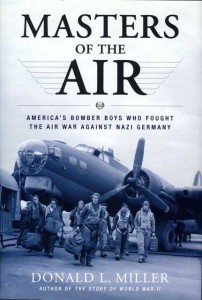God was at our wing tips I know - for no mortal could fly through that Hell alone.
Herman’s first flight in more than a month … “It was good to be back in harness. This morning the CQ pulled his usual routine at 0230 – break out at 0300, briefing at 0400. It was sure cold. The thermometer played tag at O”F, a few clouds, and a full moon.”
Did you say the CQ called you at 2:30 am? My friend Monroe F. “Buddy” Stamps defined CQ for me: “Charge of Quarters” or the Walking Alarm Clock. “Everyone cursed him,” Buddy said.
The primary target was Frankfort, although the crew ended up going to a secondary target, or a “target of opportunity.”
Herman mentions how cold it was. Weather was extremely important to the 8th Air Force heavy bomber crews, and we learned its impact on the January 11th mission.
It’s a good time for me to give credit to Donald L. Miller who wrote “Masters of the Air: America’s Bomber Boys who fought the air war against Nazi Germany.” It is so complete, so informative … it has been such a wonderful resource for me. I am flying to Pennsylvania next week and plan to study this book cover to cover.
The Air Corps worked closely with meteorologists to determine whether or not the crews could safely take off, get to the target, and make it back home. England in the winter time had predictably terrible weather. The bombers would ice up, the visibility was nil, it would be a dangerous situation all the way around.
Above the cloud at high altitudes the temperature inside the bombers would be as low as 60 degrees below zero. Although the crews wore layers of clothing which included electrical suits (like long underwear.) There were receptacles to plug in the suits at all positions but you can just imagine that they would often malfunction. Frostbite was a nagging issue.
And now are you wondering … hmmm, 7 to 10 hours in the air, leaving before daylight, in temperatures as cold as 40-60 degrees below zero … how do these boys go to the bathroom? There was no toilet. There were relief tubes which often froze. Whatever you are visualizing now … it was worse.
According to the Air Force Historical Studies Office, this was the first time the P-51 Mustang fighters accompanied the 8th Air Force bombers. Herman wrote: “The fighter support was excellent – above, below, and all around – P 47s, 38s, and 51s.”
The flak was extraordinarily heavy this day: “There was no escape … no avenue … those bastards down below were tracking us, barrages and every damn thing they could muster. Scared – that’s putting it mildly, but I grabbed the salvo handle, kept an eye on the lead ship … and prayed.
God was at our wing tips I know – for no mortal could fly through that Hell alone.”
7 down, 18 to go …



Rowdy
Posted at 18:55h, 22 MayAnother great book is “Combat Crew” written in the mid-eighties by John Comer. John was a 381st TT/FE who was ordered to write the crew’s diary by the pilot. At the end of each mission, John would gather his crew together and each would tell what they saw that day and John would write it down.
The book remained in rough draft form occupying several loose-leaf notebooks in John’s home for about 40-years before his family finally succeeded in getting him to write the book. The result is a remarkable compilation of each mission from the perspective of several crew members’ point of view.
He flew his missions entirely in 1943 and was on both of the first Schweinfurt missions.